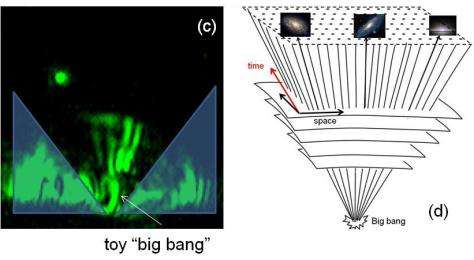April 13, 2011 report
Big Bang simulated in metamaterial shows time travel is impossible

(PhysOrg.com) -- By observing the way that light moves inside a metamaterial, researchers have reconstructed how spacetime has expanded since the Big Bang. The results provide a better understanding of why time moves in only one direction, and also suggest that time travel is impossible.
In their study, electrical engineers Igor Smolyaninov and Yu-Ju Hung from the University of Maryland have built a metamaterial by patterning plastic strips on a gold substrate, which they then illuminated with a laser. Because the mathematics of electromagnetic spaces (which describe the metamaterial) is similar to the mathematics of general relativity (which describe spacetime), the way light moves in the metamaterial is exactly analogous to the path - or “world line” - of a massive particle in (2+1)-dimensional Minkowski spacetime.
As the researchers explained in their study, a Big Bang event occurs in the metamaterial when the pattern of light rays expands relative to the time-like z-dimension. This instance marks the beginning of cosmological time, which moves forward from the Big Bang in the direction of the Universe’s expansion. After the Big Bang event, the light rays expand in a non-perfect way, scattered by random defects in the plastic strips until they reach a high-entropy state. This behavior represents the thermodynamic arrow of time, showing that entropy tends to increase in an isolated system.
The significance of these observations is that the cosmological and the thermodynamic arrows of time coincide, with both of them pointing “forward” (just as we perceive them). While most scientists theorize that the statistical and the cosmological arrows of time are connected in this way, this experiment is one of the few ways in which scientists can “replay the Big Bang” and experimentally demonstrate the connection.
The researchers also showed that this novel model of time could provide insight into time travel that involves closed timelike curves (CTCs). CTCs are world lines of particles that form circles so that they return to their starting points.
At first, the researchers thought that, if they could build a metamaterial in which light could move in a circle (and so that its mathematical description were identical to particles moving through spacetime), then they could create CTCs.
But when further analyzing the situation, they found restrictions on how light rays could move in the model. Although certain rays could return to their starting points, they would not perceive the correct timelike dimension. In contrast, rays that do perceive this timelike dimension cannot move in circles. The researchers concluded that Nature seems to resist the creation of CTCs, and that time travel - at least in this model - is impossible.
More information: Igor I. Smolyaninov and Yu-Ju Hung. "Modeling of Time with Metamaterials." arXiv:1104.0561v1 [physics.optics]
© 2010 PhysOrg.com


















